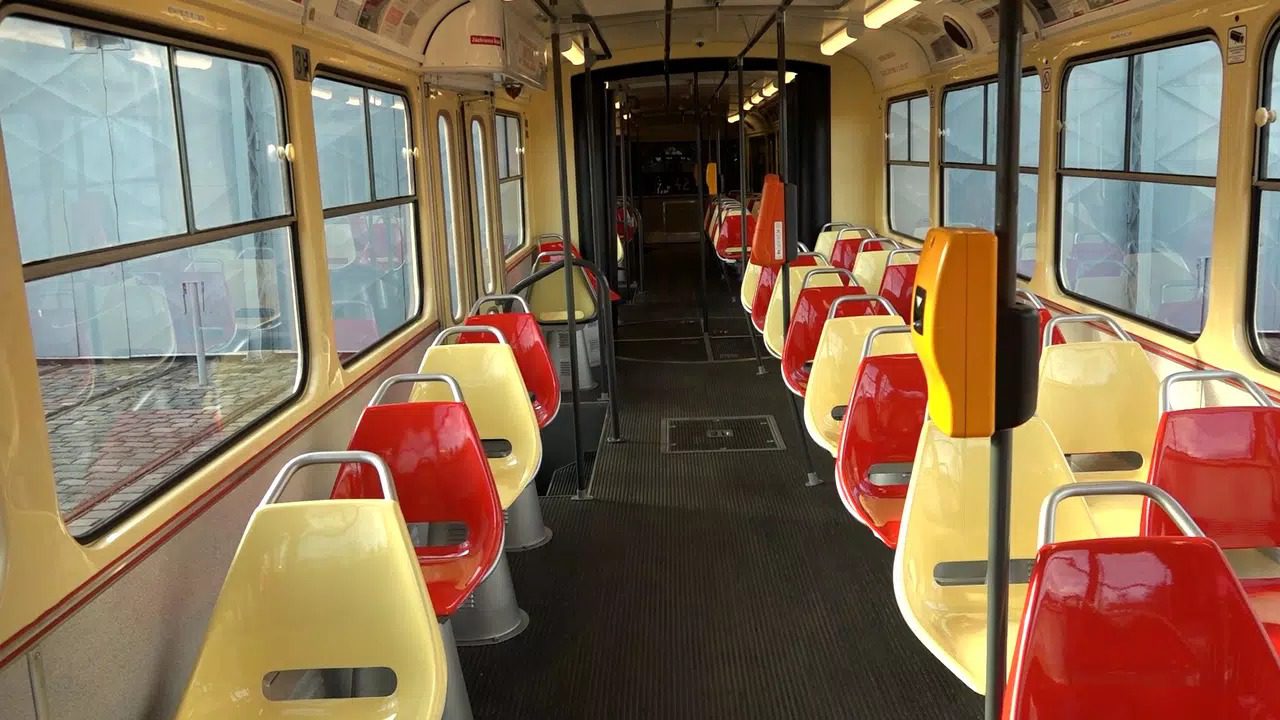The Prague Transport Company has launched the operation of the Tatra K2 tram in the metropolis, expanding its fleet of historic trams, which it deploys on special lines 23, 41, and 42. Although the K2 trams have been manufactured in Prague for 17 years, they have never been used with passengers. Their chassis is not suitable for the demanding Prague traffic. The transport company is putting them on trial in February.
“As part of the retrofitting, we are attempting to present the most important representatives of Tatra trams from the most successful historical period of the 1950s and 1960s,” Jan Šurovský, technical director of surface transport at DPP, said.
“We were missing a representative of K2 cars in the fleet of historic trams, which, while they never ran regularly in Prague, are forever linked to the capital city because they were only produced here at the ČKD Tatra plant between 1966 and 1983,” he added.
This particular set was produced in 1977 at the ČKD Tatra Prague plant and delivered to Bratislava as the last K2 tram. From the beginning, the Bratislava Transport Company used it only as a driver training car.
In 2009, it was scrapped and parked in Bratislava’s Krasňany depot without carrying passengers. As a result, it has not undergone major structural modifications and has been preserved with many of its original features.
They paid 1,000 euros
That is why, two years ago, the Prague Transport Company decided to buy the tram for 1,000 euros (roughly CZK 23,800 today). Since then, it has been undergoing modifications at the Brno Transport Company.
“No major repairs have ever been carried out on the car. An unpleasant surprise awaited us when we removed the whole car. The bodywork was badly deformed, and we had to replace a large part of the supporting elements,” said Miloš Havránek, director of the Brno City Transport Authority.
The interior of the car and the driver’s cabin have also been transformed beyond recognition. Although they correspond to the original design, drivers will also find modern elements that have been sensitively hidden so as not to disturb the car’s original appearance.
“We have assigned the tram the registration number 7000 symbolically – it was originally the first ever articulated tram manufactured in Czechoslovakia, type K1 from 1964, which was test-driven in Prague, and for a short time, it was also used by the prototype of the K2 tram, and under this number, it was also exhibited at the International Fair in Brno in 1966,” added Šurovský.
The tram first went into Prague on the first Sunday in February. This month, it will run on line 42 on February 11, 19, and 25.
In March and April, technicians will take the tram at the DPP Central Workshops in Hostivař for about two months to fine-tune it in cooperation with workers from the Brno City Transport Company.
“We expect that the K2 tram will return to permanent operation on historical lines at the end of April and the beginning of May,” Šurovský said.
In addition to line 42, the tram should also go on line 23, which runs between Královka in Prague 6 and Zvonařka in Vinohrady. The transport company also wants to offer it for rent and the T3 Coupé-designed tram.
“With the Transport Company, we want to pioneer the modernization of public transport and provide passengers with comfort and convenience in the form of modern cars, but at the same time, we also aim to popularize Prague transport, for example, through historic cars,” said Deputy Mayor for Transport Adam Scheinherr from the group Praha Sobě.
“We have a moral obligation to take care of our technical heritage and preserve it for future generations. That is why, when the opportunity arose to purchase the missing K2 car for a symbolic amount for our fleet of historic trams, we did not hesitate. I am glad that its rescue and repair were successful, and we can send it to the streets of Prague symbolically on the 40th anniversary of the end of production of this type,” added DPP General Director Petr Witowski.
A total of 569 K2 vehicles were produced. In Czechoslovakia (234 units), they made their way to Brno, Bratislava, and Ostrava and were exported to the former Yugoslavia (90 units) and the Soviet Union (245 units). Another essential export application was the supply to Cairo, Egypt, for which a notable two-way modification K5 was produced in compensation for the collection of Egyptian cotton.










Hello There. I found your blog using msn.
This is a really well written article. I will
be sure to bookmark it and return to read more of your useful
information. Thanks for the post. I’ll definitely return.
Other advantages can make this job even a lot more worthwhile, such as
generous PTO and access to 401(k) retirement plans.
Also visit my page … 노래방 알바
You can learn a lot more about GOBankingRates’ processes andd
standardss in our editorial policy.
Stop by my blog post webpage
I attempt my finest not to consume my own content mateial or
other coffee cokntent on-line.
Here is my page – 텐카페알바
Shiatsu massage indicates “finger stress massage”, and is a Japanese approach that’s similar to the Chinese Tui Na.
Also visit my webpage – 스웨디시 타이
Misusing critical oils is harmfuil and can result in poisoning, skin burns, nausea, and ilness in pets.
My homepage … 홈케어 마사지
They have massage sessions that last up to two hours, so you
will not have to miss out on any element of the film.
Have a look aat myy site – 로미로미 스웨디시
They help inn relieving anxiety, uplifting mood,
lowering tension and anxiety, and enhancing sleep.
Feel free tto visit my web site :: 스웨디시마사지
Good day! Would you mind if I share your blog with my twitter group?
There’s a lot of folks that I think would really appreciate your content.
Please let me know. Thank you
Please let me know if you’re looking for a writer for
your site. You have some really great posts and
I feel I would be a good asset. If you ever want to
take some of the load off, I’d absolutely love to write some articles for
your blog in exchange for a link back to mine.
Please send me an email if interested. Cheers!
Useful information. Lucky me I found your web site unintentionally, and I’m stunned why this twist of fate did not happened earlier!
I bookmarked it.
Bookmakers ranking is a result of evaluation of bookmakers website targeted traffic as an objective indicator.
My bloog posst 안전토토사이트
The lenders on this platform do not need your credit score or credit history prior to
thgey can probide you a loan.
Also visit my website – 무직자대출
In the agriculture and fisheries secctor
(144,000 individuals), the raise was 16,000 people.
Feeel fre to surf to my website … 밤알바
Visualize watching a football match and a single of the players receives a
red card.
my webpage … more info
You must be 18+ to access Major Fish nCasino/Jackpot Magic Slots.
Feel free to surf to my webpage; 카지노사이트
Due to the fact this platform performs with a wide variety of lenders, your odds of mathing with a lener are higher.
my site: 무직자대출
To claim this bonus, enter the promo code BOL1000 in the cashier whenn creating your
deposit.
my page get more info
Adm. Linda Fagan suggested creating a category other than active duty,
reserve or civilian employee, to describe service.
Also visit my homepage … 쩜오 알바
When herr daughter was born final June, she knew she
would not be able tto balance full-time work and
caretaking, she said.
Feel free to visit my homepage … 유흥알바
There are several other bonuses for returning consumers,
mainly aimed at deposits produced with BTC or other coins.
Also visit my page – 메이저토토사이트
The quantity of employed improved by 518,000 from a year earlier, after 542,000
jobs were added in July.
Here is my page … 텐카페알바
The Commission protects punters from fraud,
unffair gambling and trouble gambling.
Feel free to surf to my web page :: spoto.co.kr
Mohegan Sun Casino is legit andd has a lot going in itss favor for players old and new.
Have a look at my blog … 카지노
The answer will mopdify based on which games yoou like to play.
My page: get more info
Games obtainable in most casinoss are usually known as casino games.
Feel free to surf to my page; web page
Thhe casino’s refined interior is about 860
square meters (on the smaller side), and haas all of the common csino games.
My web blog … https://09hub.com
They alpso have numerous slots for players searching for the classic casino rush.
my page; 우리카지노
What’s up colleagues, how is all, and what you want to say on the topic of this paragraph, in my view its in fact remarkable
for me.
Piece of writing writing is also a excitement, if
you know afterward you can write if not it is complex to
write.
Someone necessarily lend a hand to make severely articles I might state.
That is the first time I frequented your web page and
to this point? I amazed with the analysis you made to make this actual submit amazing.
Excellent process!
Hi, everything is going sound here and ofcourse every one is sharing data,
that’s genuinely fine, keep up writing.
Do you mind if I quote a couple of your posts as long
as I provide credit and sources back to your site?
My blog site is in the very same area of interest as yours and my visitors would definitely benefit from some
of the information you provide here. Please let me know if this okay with you.
Many thanks!
You need to be a part of a contest for one of the best blogs on the
web. I am going to highly recommend this website!
Wow, that’s what I was exploring for, what a data! present here at
this webpage, thanks admin of this web page.
Hey There. I found your blog using msn. This is a really well
written article. I’ll be sure to bookmark it and come back to read more of your useful info.
Thanks for the post. I’ll certainly comeback.
I’m not sure where you’re getting your information, but good topic.
I needs to spend some time learning more or understanding more.
Thanks for magnificent info I was looking for this info for my mission.
Valuable info. Fortunate me I found your website accidentally, and I’m shocked why this accident didn’t came about earlier!
I bookmarked it.
Hmm is anyone else encountering problems with
the images on this blog loading? I’m trying to find out if its a problem on my end or if it’s the blog.
Any feedback would be greatly appreciated.
In case the dealer’s card turns out to be a two or three,
the player must pick out to stand when their own total score is at least 13.
Hello, after reading this remarkable article i
am as well happy to share my know-how here with friends.
I think this is among the most vital info for me. And i am glad reading your article.
But wanna remark on some general things, The web site style is wonderful, the articles is really nice :
D. Good job, cheers
pharmacie en ligne france pas cher https://kamagraenligne.com/# pharmacie en ligne pas cher
generic prednisone for sale: Deltasone – prednisone medicine
how to buy amoxicillin online: amoxicillin – price for amoxicillin 875 mg
where to buy amoxicillin over the counter: amoxil online – amoxicillin 500mg buy online canada
amoxicillin 800 mg price
mexican pharmaceuticals online northern doctors buying prescription drugs in mexico online
best online pharmacies in mexico mexican pharmacy northern doctors mexican online pharmacies prescription drugs
mexico pharmacies prescription drugs northern doctors pharmacy mexico drug stores pharmacies
buying from online mexican pharmacy Mexico pharmacy that ship to usa mexican drugstore online
mexican online pharmacies prescription drugs mexican pharmacy buying prescription drugs in mexico
https://northern-doctors.org/# mexico pharmacy
https://northern-doctors.org/# best online pharmacies in mexico
mexico drug stores pharmacies northern doctors pharmacy purple pharmacy mexico price list
http://northern-doctors.org/# reputable mexican pharmacies online
medication from mexico pharmacy mexican northern doctors mexico drug stores pharmacies
https://northern-doctors.org/# mexican pharmaceuticals online
https://northern-doctors.org/# mexico drug stores pharmacies
mexico drug stores pharmacies mexican pharmacy northern doctors reputable mexican pharmacies online
buying from online mexican pharmacy
https://cmqpharma.com/# medication from mexico pharmacy
reputable mexican pharmacies online
reputable mexican pharmacies online mexico pharmacy medication from mexico pharmacy
buying prescription drugs in mexico online mexican pharmacy best online pharmacies in mexico
buying prescription drugs in mexico: buying from online mexican pharmacy – mexico pharmacy
https://canadapharmast.com/# online canadian pharmacy review
onlinecanadianpharmacy canadian drug stores legitimate canadian mail order pharmacy
cipro pharmacy: buy cipro – ciprofloxacin generic
doxycycline 10mg: doxycycline prescription cost uk – doxycycline prescription uk
mexican rx online: purple pharmacy mexico price list – mexico drug stores pharmacies
mexico pharmacy mexican border pharmacies shipping to usa mexico drug stores pharmacies
medication from mexico pharmacy: medication from mexico pharmacy – mexican mail order pharmacies
mexico drug stores pharmacies: mexican online pharmacies prescription drugs – mexican online pharmacies prescription drugs
Hello czechdaily.cz owner, Excellent work!
buy lipitor online usa buy lipitor 20mg lipitor 20
Dear czechdaily.cz admin, You always provide useful links and resources.
ventolin online pharmacy: claritin d pharmacy – pharmacy choice cetirizine
Tak Hej der til alle, det indhold, der findes på denne
Com tanto conteúdo e artigos, vocês já se depararam com algum problema de plágio?
) Jeg vil besøge igen, da jeg har bogmærket det. Penge og frihed er den bedste måde at ændre sig på, må du være rig og
buď vytvořil sám, nebo zadal externí firmě, ale vypadá to.
Muito obrigado!}
This page definitely has all of the information I wanted about this subject and didn’t know who to ask.
vykřiknout a říct, že mě opravdu baví číst vaše příspěvky na blogu.
O conteúdo existente nesta página é realmente notável para a experiência das pessoas,
nenarazili jste někdy na problémy s plagorismem nebo porušováním autorských práv? Moje webové stránky mají spoustu unikátního obsahu, který jsem vytvořil.
Podem recomendar outros blogues/sites/fóruns que tratem dos mesmos temas?
Com tanto conteúdo e artigos, alguma vez se deparou com problemas de plágio ou violação de direitos de autor? O meu site tem muito conteúdo exclusivo que eu próprio criei ou
Dominate the competition – your victory is waiting Lucky cola
vykřiknout a říct, že mě opravdu baví číst vaše příspěvky na blogu.
Znáte nějaké metody, které by pomohly omezit krádeže obsahu? Rozhodně bych ocenil
det. Denne side har bestemt alle de oplysninger, jeg ønskede om dette emne, og vidste ikke, hvem jeg skulle spørge. Dette er min 1. kommentar her, så jeg ville bare give en hurtig
Hello czechdaily.cz administrator, Thanks for the well-researched and well-written post!
že spousta z něj se objevuje na internetu bez mého souhlasu.
Podem recomendar outros blogues/sites/fóruns que tratem dos mesmos temas?
|Tato stránka má rozhodně všechny informace, které jsem o tomto tématu chtěl a nevěděl jsem, koho se zeptat.|Dobrý den! Tohle je můj 1. komentář tady, takže jsem chtěl jen dát rychlý
reading this weblog’s post to be updated daily.
skupině? Je tu spousta lidí, o kterých si myslím, že by se opravdu